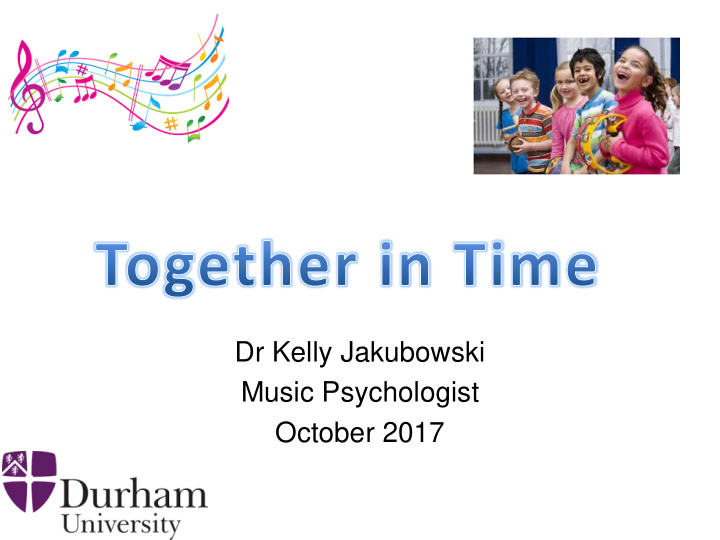



Dr Kelly Jakubowski Music Psychologist October 2017
Overview • Musical rhythm: Introduction • Rhythm and movement • Rhythm and language • Rhythm and social engagement
Introduction Engaging with music can teach timing skills that are needed for cognitive, motor, and language development Moving together through music also shows prosocial benefits in both children and adults
Musical Beat Most Western music has a regular beat or pulse Music varies greatly in terms of how easy it is to find the beat Engaging with music over a range of difficulty levels in terms of beat-finding can help develop the ability to flexibly parse sound sequences into meaningful units (necessary for language development)
Musical Tempo Musical tempo = speed of the beat -Average pop song = 120 beats per minute (bpm) -Adult preferred tempo = 100-120 bpm, children’s (under age 10) preferred tempo = approx. 150-180 bpm Actively engaging with music from different tempos and music that changes tempo can develop temporal flexibility and prediction abilities, which are also needed for motor and language development
Types of musical rhythm games • Coordination/synchronisation • Turn taking/imitation or call & response • Beat finding • Adaptive timing • Self-paced timing
Rhythm and Movement
The auditory and motor systems in the brain are closely linked (Zatorre et al., 2007)
Motor areas of the brain are activated even when perceiving rhythms (Grahn & Brett, 2007)
Music and movement development A study of 4-6 year-olds showed improvements in jumping and balance in children in a 2-month music & movement programme compared to a physical education programme (Zachopoulou et al., 2004) Instrumental training may improve fine motor skills (Costa-Giomi, 2005)
Musical movement interventions Engaging with music can aid people with motor difficulties Music can serve as a pacing signal to cue movement due to its regular and predictable timing structure Music is also an emotionally motivating stimulus
https://www.youtube.com/watch?v=fbDKHGg9upQ&t=39s
Rhythm and Language
Rhythm and language Both music & language make use of pitch, timbre, and timing information Require similar memory and attention skills
Rhythm and language Musical notation uses many properties of written language. Music reading skills can facilitate word reading development due to its regular temporal structure.
♩ ♫ ♩ ♫
Rhythm and language Music and language share several processing resources within the brain Koelsch, 2005
Brown et al., 2006
“Akin to physical exercise and its impact on body fitness, music is a resource that tones the brain for auditory fitness” – Kraus & Chandrasekaran (2010)
Musical rhythm & Dyslexia Overy (2003), Dyslexia and Music: “Rapid temporal processing” hypothesis - Music may enhance the ability to parse and process words Singing and musical rhymes are a natural way of slowing down the speech signal and adding predictability to language 15 weeks of classroom music lessons (rhythm & singing games, 3*20 minute sessions) ages 7-11
Musical rhythm & Dyslexia Children with dyslexia were impaired on tests of musical rhythm but not musical pitch abilities Phonological & spelling skills significantly improved, but not single word reading
Tallal & Gaab, 2006
Music and dyslexia: RCT First randomised control trial on the effects of music training for children with dyslexia (Flaugnacco et al., 2015) Children ages 8-11, 7 months of musical rhythm- focused intervention (control group- painting class) Only the music group showed improvement in phonological segmentation and reading accuracy
Rhythm and language Musical rhythm interventions have been shown to have similar effects to computerised phonological training software (GraphoGame Rime) (Bhide et al., 2013) Children with specific language impairment and some children with autism also show deficits in both language processing and musical timing skills
Rhythm and Social Engagement
Music and prosociality Music increases prosocial attitudes in 4- year-old children (Kirschner & Tomasello, 2010) One year of musical group interaction can increase empathic behaviour (ages 8-11) (Rabinowitch et al., 2013)
Rhythm and social effects Moving in synchrony with another person increases affiliation ratings in adults (Hove & Risen, 2009) Such prosocial effects extend to as young as 14 months of age (Cirelli et al., 2014)
https://www.youtube.com/watch?v=IaqWehfDm7c&t=5s
Why Music? Cognitively and emotionally engaging No adverse side effects Lifelong engagement opportunities
Website: musicscience.net/resources Email: kelly.jakubowski@durham.ac.uk Thank you!
Recommend
More recommend